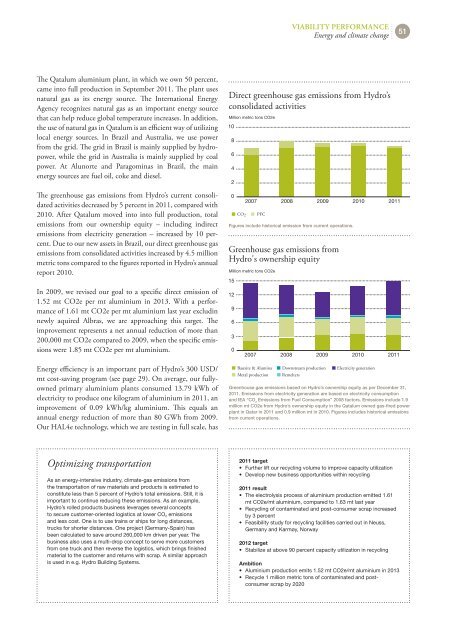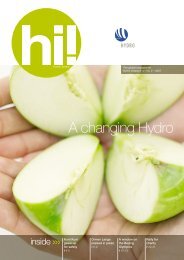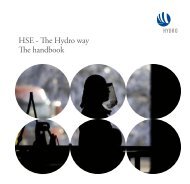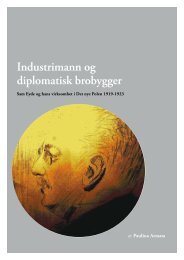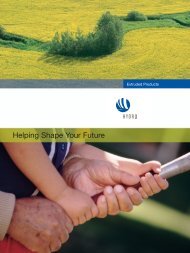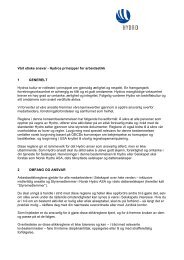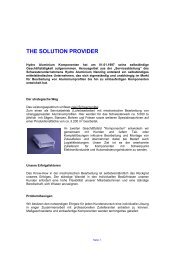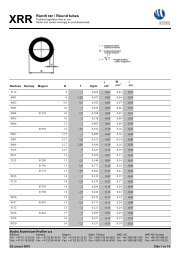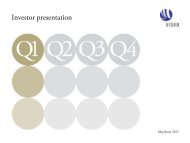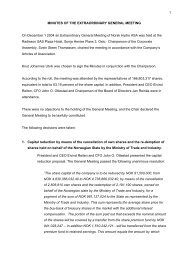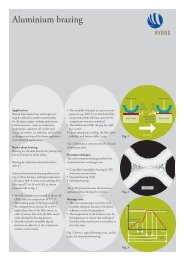Hydro Annual Report 2011b
Hydro Annual Report 2011b
Hydro Annual Report 2011b
Create successful ePaper yourself
Turn your PDF publications into a flip-book with our unique Google optimized e-Paper software.
The Qatalum aluminium plant, in which we own 50 percent,<br />
came into full production in September 2011. The plant uses<br />
natural gas as its energy source. The International Energy<br />
Agency recognizes natural gas as an important energy source<br />
that can help reduce global temperature increases. In addition,<br />
the use of natural gas in Qatalum is an efficient way of utilizing<br />
local energy sources. In Brazil and Australia, we use power<br />
from the grid. The grid in Brazil is mainly supplied by hydropower,<br />
while the grid in Australia is mainly supplied by coal<br />
power. At Alunorte and Paragominas in Brazil, the main<br />
energy sources are fuel oil, coke and diesel.<br />
The greenhouse gas emissions from <strong>Hydro</strong>’s current consolidated<br />
activities decreased by 5 percent in 2011, compared with<br />
2010. After Qatalum moved into into full production, total<br />
emissions from our ownership equity – including indirect<br />
emissions from electricity generation – increased by 10 percent.<br />
Due to our new assets in Brazil, our direct greenhouse gas<br />
emissions from consolidated activities increased by 4.5 million<br />
metric tons compared to the figures reported in <strong>Hydro</strong>’s annual<br />
report 2010.<br />
In 2009, we revised our goal to a specific direct emission of<br />
1.52 mt CO2e per mt aluminium in 2013. With a performance<br />
of 1.61 mt CO2e per mt aluminium last year excludin<br />
newly aquired Albras, we are approaching this target. The<br />
improvement represents a net annual reduction of more than<br />
200,000 mt CO2e compared to 2009, when the specific emissions<br />
were 1.85 mt CO2e per mt aluminium.<br />
Energy efficiency is an important part of <strong>Hydro</strong>’s 300 USD/<br />
mt cost-saving program (see page 29). On average, our fullyowned<br />
primary aluminium plants consumed 13.79 kWh of<br />
electricity to produce one kilogram of aluminium in 2011, an<br />
improvement of 0.09 kWh/kg aluminium. This equals an<br />
annual energy reduction of more than 80 GWh from 2009.<br />
Our HAL4e technology, which we are testing in full scale, has<br />
Optimizing transportation<br />
As an energy-intensive industry, climate-gas emissions from<br />
the transportation of raw materials and products is estimated to<br />
constitute less than 5 percent of <strong>Hydro</strong>’s total emissions. Still, it is<br />
important to continue reducing these emissions. As an example,<br />
<strong>Hydro</strong>’s rolled products business leverages several concepts<br />
to secure customer-oriented logistics at lower CO 2 emissions<br />
and less cost. One is to use trains or ships for long distances,<br />
trucks for shorter distances. One project (Germany-Spain) has<br />
been calculated to save around 260,000 km driven per year. The<br />
business also uses a multi-drop concept to serve more customers<br />
from one truck and then reverse the logistics, which brings finished<br />
material to the customer and returns with scrap. A similar approach<br />
is used in e.g. <strong>Hydro</strong> Building Systems.<br />
Direct greenhouse gas emissions from <strong>Hydro</strong>’s<br />
consolidated activities<br />
Million metric tons CO2e<br />
10<br />
8<br />
6<br />
4<br />
2<br />
0<br />
CO2<br />
2007<br />
PFC<br />
2008<br />
2009<br />
Greenhouse gas emissions from<br />
<strong>Hydro</strong>'s ownership equity<br />
Million metric tons CO2e<br />
15<br />
12<br />
9<br />
6<br />
3<br />
0<br />
2007<br />
2008<br />
vIABIlItY perForMAnCe<br />
Energy and climate change<br />
Figures include historical emission from current operations.<br />
2009<br />
2010<br />
2010<br />
Bauxite & Alumina Downstream production Electricity generation<br />
Metal production Remelters<br />
2011 target<br />
• Further lift our recycling volume to improve capacity utilization<br />
• Develop new business opportunities within recycling<br />
2011 result<br />
• The electrolysis process of aluminium production emitted 1.61<br />
mt CO2e/mt aluminium, compared to 1.63 mt last year<br />
• Recycling of contaminated and post-consumer scrap increased<br />
by 3 percent<br />
• Feasibility study for recycling facilities carried out in Neuss,<br />
Germany and Karmøy, Norway<br />
2012 target<br />
• Stabilize at above 90 percent capacity utilization in recycling<br />
2011<br />
2011<br />
Ambition<br />
• Aluminium production emits 1.52 mt CO2e/mt aluminium in 2013<br />
• Recycle 1 million metric tons of contaminated and postconsumer<br />
scrap by 2020<br />
51<br />
Greenhouse gas emissions based on <strong>Hydro</strong>’s ownership equity as per December 31,<br />
2011. Emissions from electricity generation are based on electricity consumption<br />
and IEA “CO 2 Emissions from Fuel Consumption” 2008 factors. Emissions include 1.9<br />
million mt CO2e from <strong>Hydro</strong>’s ownership equity in the Qatalum owned gas-fired power<br />
plant in Qatar in 2011 and 0.9 million mt in 2010. Figures includes historical emissions<br />
from current operations.


